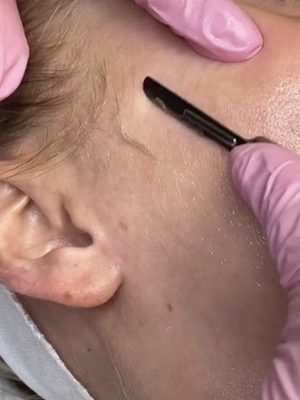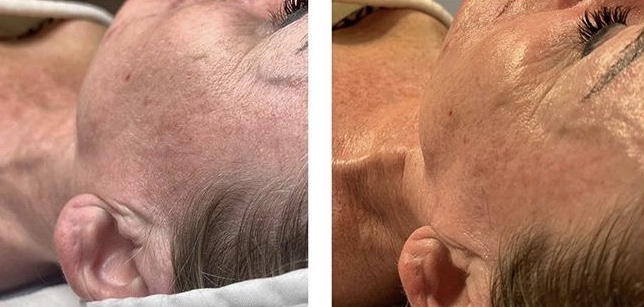Dermaplaning
- Home
- |
- Dermaplaning
Treatments
What is dermaplaning?
Dermaplaning is a skin treatment that uses a scalpel to skim the dead skin cells and vellus (peach fuzz) hairs from the face and neck leaving the skin flawless and glowing. It improves the skins texture, unblocks blackheads, enhances penetration of products and allows for make up to glide on perfectly

Is dermaplaning suitable for everyone and what does it treat?
Dermaplaning is suitable for most people except those with cystic or active acne. It has no downtime, no risks and you will not have to take any time off from work, you could even fit it into your lunch break!
It is often used to treat the following skin types:
- Dull skin
- Dry skin
- Sun-damaged skin
- Fine lines

Can dermaplaning be combined with other treatments?
Absolutely! Dermaplaning can be combined with many other treatments such as microneedling and chemical peels. As it removes all the dead skin cells, dirt and vellus hairs from the surface of the skin, it allows for other treatments be become more effective and topicals to better penetrate the skin
Dermaplaning
- Home
- |
- Dermaplaning
What are Dermal Fillers used for?
- Replace volume loss from the mid-face and temples
- Elevate and reposition eyebrows which have dropped
- Replace volume loss in the temples
- Lift Jowels and sagging of the jawline
- Treat volume loss in the hands
- Reshape the nose
- Enhance Cheeks
What Dermal Fillers do you use?
- Belotero
- Juvederm
- Teosyal
- Restylane/Perlane
These products are made from Hyaluronic Acid which is a complex polysaccharide (sugar) found in a number of sites in our bodies – Joints, Skin, Eyes. As the structure is identical to that in our bodies and as there is no animal product, the risk of allergies is minimal and allergy testing is not therefore required.
Other fillers used for specific indications include:
- Radiesse
- Ellanse
- Sculptra
Who will perform the treatment?
What are the common Side effects with Dermal Filler Treatments
Before deciding the treatment with dermal fillers, a number of general health aspects need to be clarified. A particular tendency to bruising, medication that thins the blood, like aspirin, warfarin or clopidogrel may also lead to significantly more bruising and swelling and needs to be known in advance. The risk or allergic reactions with current dermal fillers is very low and they do not require preliminary allergy testing. Redness, swelling and bruising at the point of injection are possible with all types of fillers, and most frequently are limited to one or two days after the treatment. More prolonged redness or swelling is possible and will been to be brought to the attention of your doctor promptly.
The risk of infection is present whenever using injectable treatments and is a consideration also with fillers. Typically, the treatment does not require an antibiotic cover, but if you have any suspicion of an infection, you need to discuss your concerns promptly with your doctor. Thorough cleaning of the skin before treatment is essential.
Pain at the injection site is usually limited, and the treatment can be carried out either using local anaesthetic cream, local anaesthetic injections or no anaesthetic depending on individual preferences.
Delayed side effects include the formation of lumps. if the Dermal Filler used is composed of Hyaluronic Acid ( Juvederm, Beltero, Teosyal, Restylane etc) this is rare and these can usually be dissolved quite easily with Hyalase. Other products such as Radiesse, Sculptra, Ellanse etc that are often promoted as longer lasting but may have an increased risk and this should be discussed with your doctor. They can often be managed medically but in very rare circumstances surgical removal may be required.
How and where are the treatments provided?
Treatment with injectable dermal fillers is an office based procedure that usually takes less than 30 minutes. It is possible to apply local anaesthetic cream on the skin or on the lips to decrease sensation and reduce the discomfort related to the treatment, although many people find this unnecessary.
Volume augmentation of the lips can also be carried out using regional nerve block which means that the lips become completely numb, but they will take several hours to recover, similar to the dental local anaesthetic.
The results after the treatment are immediate and depending on the area treated and product used these results.
What should I do after the treatment?
After the treatment, it is important to avoid excessive rubbing to the treatment areas and application of cold is sometimes suggested. Specific advice will be given to you by Dr Jones appropriate to the area treated and product used.
